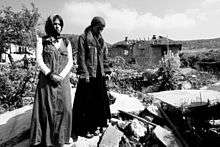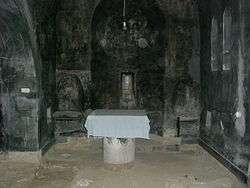2004 unrest in Kosovo
| 2004 unrest in Kosovo | |||||
|---|---|---|---|---|---|
Ruins of Serbian houses and Serbian Orthodox monasteries | |||||
| Date | 17-18 March 2004 | ||||
| Target | Kosovo Serbs, Serb houses and Serbian Orthodox churches | ||||
Attack type | Ethnic cleansing, rioting, arson, pogrom | ||||
| Deaths | 28[1] | ||||
Non-fatal injuries | 600+ | ||||
| Perpetrators | Kosovo Albanians | ||||
Number of participants | 50,000+[2] | ||||
| Wikimedia Commons has media related to 2004 unrest in Kosovo. |
Violent unrest in Kosovo broke out on 17 March 2004. Kosovo Albanians, numbering over 50,000,[3] took part in wide-ranging attacks on the Kosovo Serb minority, compared by the then Serbian Prime Minister Vojislav Koštunica to ethnic cleansing.[1] It was the largest violent incident in the region since the Kosovo War of 1998-99. According to reports by news sources in Serbia, during the unrest, civilians were killed, thousands of Serbs were forced to leave their homes, 935 Serb houses, 10 public facilities (schools, health care centers and post offices) and 35 Serbian Orthodox church buildings were desecrated, damaged or destroyed, and six towns and nine villages were ethnically cleansed.[4][5]
The events were also called the "Kristallnacht of Kosovo"[6] and in Serbia, the "March Pogrom".[3][6][7][8][9]
Background
More than 164,000 members of Kosovo's minorities had fled the province in the immediate aftermath of the war. This is especially true in the case of Serbs and Romani.[10] Ethnic tensions and territorial dispute have been a major problem in Kosovo for many years that sparked the Kosovo War of 1998-99 in which an estimated 10,000 people died, the majority being Albanian civilians, which is also the reason cited by the U.S. State Department for the NATO intervention in Yugoslavia.[11][12][13] After the end of the war, the province was administered by the UN under the auspices of the United Nations Interim Administration Mission in Kosovo (UNMIK), with security provided by the NATO-led Kosovo Force (KFOR). In 2000, there were riots and unrest in Kosovo.
Those Serbs that remained organized themselves into enclaves guarded by peacekeeping forces. Low-level violence continued after the war. The Serb minority claimed to have been subjected to "persistent intimidation and harassment", though the level of violence was reported to have declined somewhat since the end of the war. In 2003, six Serbs were shot at in an enclave. There were repeated attacks on Serbian Orthodox churches, shrines and other cultural monuments, with over a hundred being destroyed or damaged. Clashes had also broken out between Serbs and Albanians in the ethnically Serb-dominated north of Kosovo, with Albanians harassing Serbs and chasing them out of their homes.
Prelude
Shooting of Serbian teen
The initial unrest began on 15 March 2004 with the drive-by shooting of an 18-year-old Serb, Jovica Ivić, in the village of Čaglavica in the central region of Kosovo.[14]
Drowning of Albanian children
On 16 March, three Albanian children drowned in the Ibar River in the village of Čabar, near the Serb community of Zubin Potok. A fourth boy survived. It was speculated that he and his friends had been chased into the river by Serbs in revenge for the shooting of Ivić the previous day, but this claim has not been proven.[15]
UN police spokesman Neeraj Singh said the surviving boy had been under intense pressure from ethnic Albanian journalists who had suggested what he should say. His version of events differed from that of two other children who had also been in the river, Singh told a news conference in Pristina. The spokesperson said there were "very significant" inconsistencies in the accounts given by the child during two separate interviews, and a lack of corroboration of his story. "In fact, it is logically at odds in several respects with other evidence," Mr. Singh said.[16][17] The UN found no evidence that Serbs were responsible for the drowning the three Albanian children.[18]
Violence
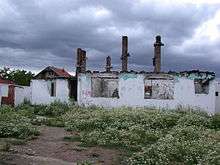
The following day thousands of Kosovo Albanians, protesting against the boys' deaths, gathered at the south end of the bridge across the Ibar at Kosovska Mitrovica, which divides the Serbian and Albanian districts of the town. A large crowd of Serbs gathered at the north end to prevent the Albanians from crossing. Peacekeepers from the NATO-led Kosovo Force (KFOR) blockaded the bridge, using tear gas, rubber bullets and stun grenades to keep the crowds apart. However, gunmen on both sides opened fire with sub-machine guns and grenades, killing at least eight people (two Albanians and six Serbs) and wounding over 300. Eleven peacekeepers were also injured, of which two seriously.
The violence continued on 18 March with further demonstrations in many localities across Kosovo, notably at Čaglavica again and also in Kosovska Mitrovica, Lipljan, Obilic and Pristina. The casualty toll at the end of the day was 28 and 600 people were injured, including 61 peacekeepers and 55 police officers. U.N. spokeswoman Isabella Karlowitz said 110 houses and 16 churches were destroyed. She also reported that around 3,600 people had been made homeless by the violence, including but not limited to Serbs, Romani, and Ashkali.[19]
In Čaglavica, 12000 Kosovo Albanian rioters tried to storm the Serb-populated areas. Norwegian peacekeepers from KFOR created a blockade by using tear gas, rubber bullets, and stun grenades, in order to keep the two groups apart. A truck was driven by a Kosovo Albanian at full speed towards the barricade in an attempt to penetrate the line. After firing warning shots at the truck, the Norwegians had to use deadly force to avoid friendly casualties, and shot the driver. 16 Norwegian peacekeepers were injured, and 13 of them had to be evacuated.[20] Another KFOR unit consisting of mostly Swedish soldiers also participated in defending Čaglavica that day, supported by people from the barracks who normally worked with non-military tasks. Lieutenant Colonel Hans Håkansson, who commanded 700 people during the unrest, reported that the fighting went on for 11 hours, and that many collapsed due to dehydration and broken limbs while struggling to fend off waves of rioters.[21] In total, 35 people were injured while defending the town.[21] Hans Håkansson was awarded with a medal for his actions by the Royal Swedish Academy of War Sciences in 2005.[22]
Attacks
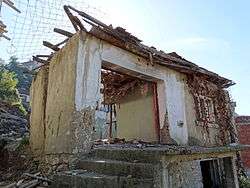
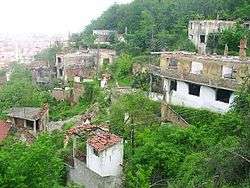
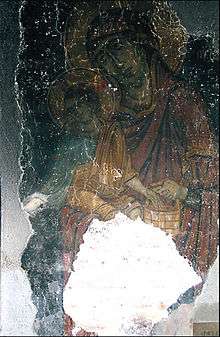
The violence quickly spread to other parts of Kosovo, with Kosovo Serb communities and religious and cultural symbols attacked by crowds of Albanians. Some of these locations were ostensibly under the protection of KFOR at the time. During the riots and violence, eight Kosovo Serbians were killed. Among damaged property was the targeted cultural and architectural heritage of the Serb people, and as a result 35 churches, including 18 monuments of culture, were demolished, burnt or severely damaged.[3]
Čaglavica
- Čaglavica – The place where the first unrest occurred, following the murder of a Serb teen in a drive-by shooting.[14] Swedish and Norwegian KFOR units set up a blockade to protect the Serb-inhabited locations during a confrontation which lasted 11 hours. Several soldiers were injured and collapsed from physical exhaustion, one Albanian man was shot while trying to push through the blockade with a truck.[20][21]
Peć
- Belo Polje – Serb returnees attacked[23]
- Peć – rioting in which UN offices were attacked; one Albanian killed by UN police.[23]
Lipljan
- Lipljan – gunfights between KFOR and Albanians, 4 Serbs killed,[23] remaining Serbs took refugee in Orthodox Church which was attacked;
Vučitrn
- Svinjare – Serb village near Kosovska Mitrovica – all Serb houses burnt down.[21]
Prizren
On 17 March, ethnic Albanians started attacking the Serb settlement in Prizren, including the Seminary, and reportedly there was no UNMIK, Kosovo Police and KFOR present there at the time.[24] The mob set the Seminary on fire, with people inside,[24] and beat several elder people, with one man dying in the burning.[25] The German KFOR's refusal to mobilize in order to protect the Serbs are one of the main security failures of the 2004 unrest.[25] UNMIK in Prizren said that the terror, 56 Serb houses and 5 historical churches that were burnt down, could have been prevented by the KFOR.[25]
Drenica
- Drenica – Devič Monastery burnt down and desecrated.[21]
Destroyed churches
In a statement on 18 March, the Serbian Orthodox Church reported that a number of its churches and shrines in Kosovo had been damaged or destroyed by rioters. These included:[26][27]
- Saint Elijah Church in Podujevo destroyed and desecrated, coffins from the nearby Serbian cemetery were dug up, and bones of the dead were scattered away.[28]
- Srbica: Devič Monastery, nuns evacuated by Danish soldiers, monastery pillaged and torched, the tomb of St. Joannicius of Devič was desecrated.[29][30]
- Our Lady of Ljeviš in Prizren from 1307 (UNESCO World Heritage Site)[31]
- the Church of Holy Salvation in Prizren,[31] destroyed by vandals after German KFOR troops had left the site.[21]
- Church of St. George in Prizren[31] (the city's largest church)
- Church of St. George in Prizren[31] (Runjevac)
- Church of St. Kyriaki, Church of St. Nicolas (Tutić Church) in Prizren[31]
- the Monastery of The Holy Archangels in Prizren[31] as well as
- Prizren's Orthodox seminary of Saint Cyrillus and Methodius in Prizren[31]
Serbian reaction
The events in Kosovo brought an immediate angry reaction on the streets of Serbia. On the evening of 17 March, crowds gathered in Belgrade, Novi Sad and Niš to demonstrate against the treatment of the Kosovo Serbs. Despite appeals for calm by Metropolitan Amfilohije, the 17th-century Bajrakli Mosque was set on fire. Islam Aga mosque in the southern city of Niš was also set on fire, while demonstrators chanted “Kill, kill Albanians!” When police arrived the mosque was already burning and some media reported that the police didn't move the crowd, so they blocked the fire fighters access to the mosque, leaving them unable to extinguish the fire.[32] Both buildings were extensively damaged but were saved from complete destruction by the intervention of police and firefighters.[33] Also properties of Muslim minorities, such as Goranis, Turks or Albanians were vandalized in Novi Sad and other cities throughout Serbia.[34] Human Rights Watch has concluded that the Serbian state failed to prosecute violence in Novi Sad.[32]
The Serbian government publicly denounced the violence in Kosovo. Prime Minister Vojislav Koštunica gave a speech blaming organized Albanian separatists: "The events in northern Kosovo-Metohija reveal the true nature of Albanian separatism, its violent and terrorist nature ... [The government will] do all it can to stop the terror in Kosovo".[35] Koštunica strongly criticized the failure of NATO and the UN to prevent the violence, and called for a state of emergency to be imposed on Kosovo. The Minister of Minority Rights of Serbia and Montenegro, Rasim Ljajić, himself a Muslim, said "What is now happening in Kosovo confirms two things: that this is a collapse of the international mission, and a total defeat of the international community." Nebojsa Čović, the Serbian government's chief negotiator on matters relating to Kosovo, was sent to Kosovska Mitrovica on March 18 in a bid to calm the situation there. Serbian security forces also guarded the border between Serbia and Kosovo in a bid to prevent demonstrators and paramilitaries from entering the province to foment further unrest.
The Serbs, represented by the "Union of Serbs in Kosovo and Metochia", describe the ordeal as "genocide" in a letter sent to the Serbian and Russian patriarchs, to Russian President Vladimir Putin and the Serbian government, where, besides that, they quote the burning of 7 villages during the German occupation in World War II to the "several hundreds" burnt "under the rule of the troops of Christian Europe and America" and according to which the "occupation of Kosovo surpasses all we had to sustain under fascism." The spared Serbian villages are compared to "concentration camps" because of the missing liberty of moving, electricity and heating. According to the letter, after 1999 there were 8500 homicides or disappearances of non-Albanian people with no single accomplice tried. They consider a possible secession of Kosovo by the Serbian government an "unforgivable neither by God nor by the people state treason".[36]
In 2011, seven years after the incident, Foreign Minister Vuk Jeremić spoke at the Wheaton College in Chicago:
- "In less than 72 hours, 35 churches and monasteries were set on fire, many of which date back to the 14th century or even further away in history, which represents an irretrievable loss for the mankind. Dozens of people were killed. Several thousand were wounded. Thousands of houses and shops were leveled to the ground. More than 4,000 Kosovo Serbs were expelled from their homes."[3]
International reaction
The international community was taken by surprise by the sudden upsurge in violence. Kosovo had been fairly quiet since the end of 1999, although there had been occasional small-scale ethnic clashes throughout the past five years and an ongoing tension between Serbs and Albanians. This had, however, largely gone unnoticed by the Western media since 1999.
KFOR troops closed Kosovo's borders with the remainder of Serbia-Montenegro and the UN suspended flights in and out of the province. NATO announced on 18 March that it would send another 1,000 troops – 750 of them from the United Kingdom – to reinforce the 18,500 troops already there.[19][37]
The United Nations and European Union both appealed for calm, calling on local leaders to restrain their supporters. UN Secretary General Kofi Annan urged both sides to cooperate with the peacekeeping forces but pointedly reminded the Kosovo Albanians that they had a responsibility "to protect and promote the rights of all people within Kosovo, particularly its minorities".
An Organization for Security and Co-operation in Europe (OSCE) official in Austria called the events an orchestrated plan to drive out the remaining Serbs, while one anonymous UNMIK official reportedly referred to the event as Kosovo's Kristallnacht. The commander of NATO's South Flank, Admiral Gregory G. Johnson, said on 19 March that the violence verged on ethnic cleansing of Serbs by Albanians. On 20 March, Kosovo's UN administrator, Harri Holkeri, told journalists that "Maybe the very beginning was spontaneous but after the beginning certain extremist groups had an opportunity to orchestrate the situation and that is why we urgently are working to get those perpetrators into justice."[38]
According to Amnesty International, at least 19 people died—11 Albanians and eight Serbs—and over 1,000 were injured while some 730 houses belonging to minorities, mostly Kosovo Serbs, as well as 36 Orthodox churches, monasteries and other religious and cultural sites were damaged or destroyed. In less than 48 hours, 4,100 minority community members were newly displaced, (more than the total of 3,664 that had returned throughout 2003), of whom 82 per cent were Serbs and the remaining 18 per cent included Roma and Ashkali as well as an estimated 350 Albanians from the Serb majority areas of Kosovska Mitrovica and Leposavić.
 Denmark pledged to send an additional 100 peacekeepers to the region after the violence began.[39]
Denmark pledged to send an additional 100 peacekeepers to the region after the violence began.[39] Germany's Defence Minister Peter Struck said on March 19 that a further 600 peacekeepers were being sent to join German forces in Kosovo, with deployment to the region beginning on March 20.[39]
Germany's Defence Minister Peter Struck said on March 19 that a further 600 peacekeepers were being sent to join German forces in Kosovo, with deployment to the region beginning on March 20.[39] France pledged to send about 400 more troops immediately to the region after the violence began.[39]
France pledged to send about 400 more troops immediately to the region after the violence began.[39] Russia and Serbia-Montenegro called for an emergency meeting of the UN Security Council, which condemned the violence. On 19 March, the Russian Duma passed a resolution (397 to 0) calling for the return of Serbia-Montenegro's troops.
Russia and Serbia-Montenegro called for an emergency meeting of the UN Security Council, which condemned the violence. On 19 March, the Russian Duma passed a resolution (397 to 0) calling for the return of Serbia-Montenegro's troops. Serbian Prime Minister Vojislav Koštunica described the attacks as "planned in advance and co-ordinated... this was an attempted pogrom and ethnic cleansing" against Kosovo's Serbs.[39]
Serbian Prime Minister Vojislav Koštunica described the attacks as "planned in advance and co-ordinated... this was an attempted pogrom and ethnic cleansing" against Kosovo's Serbs.[39] The United Kingdom sent an additional 750 peacekeeping soldiers, which arrived in the region's capital Pristina within 24 hours of the first attacks, to reinforce British troops already on the ground.[39]
The United Kingdom sent an additional 750 peacekeeping soldiers, which arrived in the region's capital Pristina within 24 hours of the first attacks, to reinforce British troops already on the ground.[39] White House spokesman Scott McClellan told reporters the Bush administration called "on all groups to end the violence and refrain from violence."[40] The U.S. State Department also repeated its call to stop the violence, stating: "The escalating violence threatens the process of democratization and reconciliation in Kosovo and must end."[40]
White House spokesman Scott McClellan told reporters the Bush administration called "on all groups to end the violence and refrain from violence."[40] The U.S. State Department also repeated its call to stop the violence, stating: "The escalating violence threatens the process of democratization and reconciliation in Kosovo and must end."[40]
Reactions in Kosovo
Kosovo Albanian politicians such as President Ibrahim Rugova and Prime Minister Bajram Rexhepi joined UN governor Harri Holkeri, NATO southern commander Gregory Johnson, and other KFOR officials in condemning the violence and appealing for peace in Kosovo.[41]
Hashim Thaçi, the former Kosovo Liberation Army (KLA) leader, "rejected ethnic division of Kosovo and said independence is a pre-condition for stability in the region."[42] He has also said, "Kosovo, NATO and the West have not fought for Kosovo only for Albanians, nor for a Kosovo ruled by violence. Violence is not the way to solve problems, violence only creates problems."[43]
Kosovo Police established a special investigation team to handle cases related to the 2004 unrest and according to Kosovo Judicial Council by the end of 2006 the 326 charges filed by municipal and district prosecutors for criminal offenses in connection with the unrest had resulted in 200 indictments: convictions in 134 cases, and courts acquitted eight and dismissed 28; 30 cases were pending. International prosecutors and judges handled the most sensitive cases.[44] By March 2010, 143 Kosovars of Albanian ethnicity were convicted, of which 67 received prison terms of over a year.[45]
See also
- Persecution of Serbs
- Gračanica bus bombing
- Stolen Kosovo, documentary
- Iconoclasm
- 2008 unrest in Kosovo
Notes and references
Notes:
References:
- 1 2 "Kosovo clashes 'ethnic cleansing'". BBC News. 20 March 2004. Retrieved 22 April 2010.
- ↑ Commentary No. 87: The Status of Kosovo: Political and Security Implications for the Balkans and Europe
- 1 2 3 4 B92.net, FM talks Kosovo at U.S. college, 18 March 2011
- ↑ "Patriarch in memorial service for victims". B92. 17 March 2010. Retrieved 7 September 2015.
- ↑ "11 years since "March Pogrom" of Serbs in Kosovo". B92. 17 March 2015. Retrieved 7 September 2015.
- 1 2 Anti-Serb programs in Kosovo, By The Washington Times
- ↑ Шест година од мартовског погрома RTS.rs
- ↑ Martovski pogrom Večernje novosti
- ↑ "ЕПИСКОП ФЕОДОСИЙ ПРОТИВ ПЕРЕДАЧИ МОНАСТЫРЯ ПОД ОХРАНУ КОСОВСКОЙ ПОЛИЦЕЙСКОЙ СЛУЖБЫ". Retrieved 15 February 2015.
- ↑ "Human Rights Watch". Retrieved 23 May 2006.
- ↑ "Ethnic Cleansing in Kosovo". Retrieved 5 November 2011.
- ↑ "Killings and Refugee Flow in Kosovo March - June 1999" (PDF). Retrieved 5 November 2011.
- ↑ "Expert Report". Retrieved 5 November 2011.
- 1 2 "U Čaglavici pucano na srpskog mladića iz automobila u pokretu". B92. Beta. 15 March 2004. Retrieved 21 December 2014.
- ↑ "No evidence over Kosovo drownings". BBC. 2004-04-28. Retrieved 2010-01-05.
- ↑ "Lack of evidence stalls probe into drowning of 3 Kosovo children, UN Mission says". ReliefWeb. Retrieved 15 February 2015.
- ↑ "UN Investigation Clears Serbs of Kosovo Drownings". 29 April 2004. Retrieved 15 February 2015.
- ↑ "UN Investigation Clears Serbs of Kosovo Drownings". 29 April 2004. Retrieved 15 February 2015.
- 1 2 "Kosovo rioters burn Serb churches". BBC. 2004-03-18. Retrieved 2009-12-31.
- 1 2 Kjell-Olav Myhre (2014). Kosovo 2004: 12000 kosovoalbanerne angriper den kosovoserbiske landsbyen Caglavica [Kosovo 2004: 12000 Kosovo Albanians assault the Kosovo Serb village of Caglavica] (in Norwegian). Forsvaret (Norwegian Armed Forces). Archived from the original on 2014-07-14. Retrieved 2014-05-09.
- 1 2 3 4 5 6 Zaremba, Maciej (15 June 2007). "Mandom, mod och landstingstossor". Dagens Nyheter. Retrieved 9 May 2014.
- ↑ "Gotländsk militär får belöningsmedalj". P4 Gotland. Sveriges Radio. 8 November 2005. Retrieved 11 January 2015.
- 1 2 3 b92: Hronologija događaja (16 - 22. mart 2004) (Serbian)
- 1 2 Bouckaert 2004, p. 54.
- 1 2 3 Bouckaert 2004, p. 55.
- ↑ b92: Dopunjeni i ispravljeni spisak uništenih i oštećenih pravoslavnih crkava i manastira na Kosovu u toku martovskog nasilja (26 April 2004) (Serbian)
- ↑ „Porušeni manastiri na Kosovu i Metohiji“ on YouTube, Office for Kosovo and Metohija (English)(Serbian)
- ↑ Munk, Eva (25 March 2004). "Czechs hold line in Kosovo". The Prague Post.
- ↑ "CNN - KLA rebels accused of vandalizing Serb monastery - June 17, 1999". edition.cnn.com. Retrieved 2014-03-03.
- ↑ http://www.sv-luka.org/Kosovo2000Part1.pdf
- 1 2 3 4 5 6 7 "Reconstruction Implementation Commission". Site on protection list. Retrieved 9 December 2010.
- 1 2 Dangerous Indifference: Violence against Minorities in Serbia: March 2004 Violence Against Albanians and Muslims
- ↑ "Churches & mosques destroyed amid inter-ethnic violence". KOSOVO & SERBIA. F18 News. Retrieved 23 May 2006.
- ↑ "Dangerous Indifference: Violence against Minorities in Serbia: March 2004 Violence Against Albanians and Muslims". Retrieved 15 February 2015.
- ↑ "Media fan Kosovo flames". BBC. 2004-03-18. Retrieved 2009-12-31.
- ↑ Full text of the letter in Russian, in the name of 120 000 Serbs in Kosovo and Metochia
- ↑ "NATO deploys "prudent reinforcements" to Kosovo in response to violence". NATO. Archived from the original on 29 May 2006. Retrieved 23 May 2006.
- ↑ "Kosovo clashes 'orchestrated'". BBC. 2004-03-20. Retrieved 2009-12-31.
- 1 2 3 4 5 Kosovo clashes 'ethnic cleansing' BBC, March 20, 2004. Retrieved 2011-01-28.
- 1 2 NATO rushes troops to Kosovo CNN, March 18, 2004. Retrieved 2011-01-28.
- ↑ Bouckaert (2004), p.59
- ↑ "Independence Key to Stability in Kosovo, says Leading Politician". Voice of America (published March 18, 2004). October 29, 2009. Retrieved September 28, 2015.
- ↑ "Thaçi calls upon citizens to stop protests and not forget the help of NATO (Zëri)" (PDF). March 19, 2004. Archived from the original (PDF) on May 5, 2005. Retrieved September 28, 2015.
- ↑ "Country Report on Human Rights Practices in Serbia (includes Kosovo)". US Department of State. March 6, 2007. Retrieved September 28, 2015.
- ↑ "Six years since March violence in Kosovo". B92. 17 March 2010. Retrieved 7 September 2015.
Sources
- "Ethnic Violence in Kosovo, March 2004" (PDF). Humanitarian Law Center.
- Bouckaert, Peter (2004). Failure to Protect: Anti-minority Violence in Kosovo, March 2004. Human Rights Watch. pp. 43–. GGKEY:XX8XTDK4E19.
- Siobhán Wills (26 February 2009). Protecting Civilians: The Obligations of Peacekeepers. Oxford University Press. pp. 220–. ISBN 978-0-19-953387-9.
- Branko, Jokić (2014). The March Pogrom. Centar za očuvanje nasleđa Kosova i Metohije - Mnemosyne Beograd, Muzej u Prištini Priština, Kancelarija za Kosovo i Metohiju Beograd. ISBN 978-86-84431-13-6.
- "Осам година од погрома на Космету". RTS. March 17, 2012.
- "Деценија од погрома на Космету". RTV. March 17, 2014.
- Влада Републике Србије за Косово и Метохију (March 2004). "Терор на Косову и Метохији".
- Влада Републике Србије за Косово и Метохију. "Мартовски погром 2004. године".
- Destroyed cultural monuments
- Влада Републике Србије за Косово и Метохију. "Светиње и културна добра уништени у мартовском погрому" (PDF).
- Влада Републике Србије за Косово и Метохију. "Судбина културне баштине на Косову и Метохији" (PDF).
- Влада Републике Србије за Косово и Метохију. "Уништена и оштећена културна добра на Косову и Метохији у периоду од 1999. до 2004. године" (PDF).
- Влада Републике Србије за Косово и Метохију. "Угрожена културна добра на Косову и Метохији" (PDF).
External links
- Pictures of the violence and its aftermath
- Christopher Deliso, "An Uncertain Future for the Serbian Refugees in Kosovo," Antiwar.com, April 7, 2004
- Christopher Deliso, "The Internationals and the Mobs: Kosovo's Moment of Truth," Antiwar.com, April 15, 2004
- The reaction in Serbia, where non-Serbian property was vandalized by Serbian mobs.
- SEE Security Monitor: Seven years since Albanian pogrom against Serbs in Kosovo
- Caglavica during the Kosovo unrest 2004 (eng. subtitles)
| Wikimedia Commons has media related to 2004 unrest in Kosovo. |



